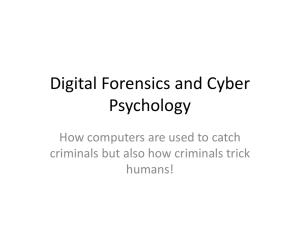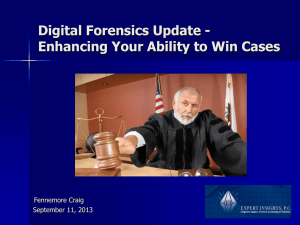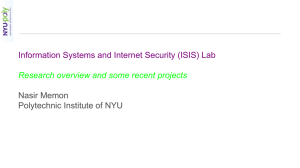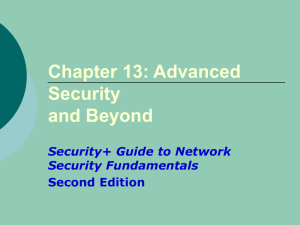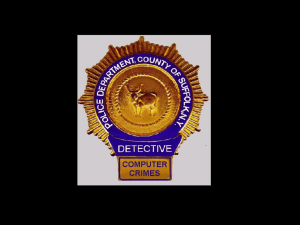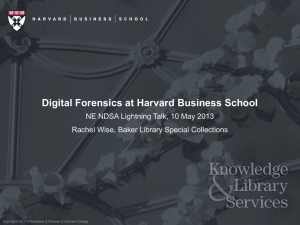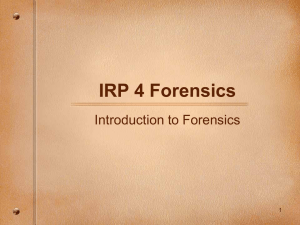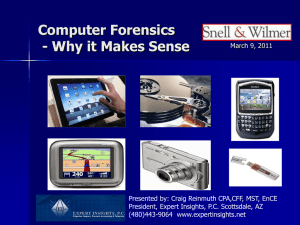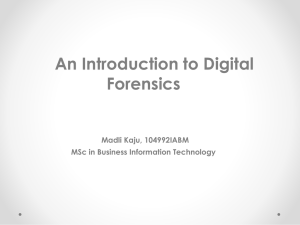Recovering Data
advertisement
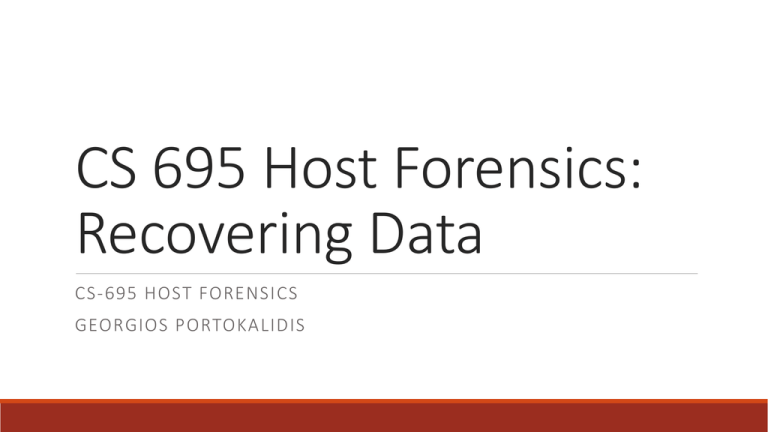
CS 695 Host Forensics: Recovering Data CS-695 HOST FORENSICS GEORGIOS PORTOKALIDIS Categories of Data on Disk Existing data Deleted data Partially overwritten data Data wiped or cleaned CS-695 HOST FORENSICS 2 FAT32: How Are Files Stored? CS-695 HOST FORENSICS 3 FAT32: How Are Files Deleted? CS-695 HOST FORENSICS 4 NTFS: How Are Files Stored? Recovery.txt Meta-data Clusters B-tree ..... X Bitmap keeps track of cluster usage CS-695 HOST FORENSICS 5 NTFS: How Are Files Deleted? Recovery.txt Meta-data X Clusters B-tree XX X X ..... X Bitmap keeps track of cluster usage CS-695 HOST FORENSICS 6 Unix: How Are Files Stored? CS-695 HOST FORENSICS 7 Unix: How Are Files Deleted? X CS-695 HOST FORENSICS 8 Unix: Reclaiming Disk Space Used inodes list Free inodes list Used data blocks list Free data blocks list a a b b Inode: 123 Filename: foo CS-695 HOST FORENSICS 9 Meta-data Survives The name of the file Meta-data ◦ Permissions, MAC times, file attributes, etc. Location (partial) of data Last directory entries survive This information can be easily destroyed on a live system CS-695 HOST FORENSICS 10 Basic SleuthKit inode Commands List contents of directory ◦ icat image.dd 2 | strings ◦ inode nr 2 corresponds to / ◦ fls image.dd 2 List all inodes ◦ ils –a image.dd Recover file pointed to by inode ◦ icat image.dd inode-number Discover directory entries linked to an inode ◦ ffind CS-695 HOST FORENSICS 11 SleuthKit Dealing with Blocks Recap: inodes hold meta-data, blocks hold content Summary of inode: ◦ istat image.dd inode-nr Show block contents ◦ blkcat image.dd block-nr List all blocks ◦ blkls –e image.dd ◦ Useful for searching all blocks CS-695 HOST FORENSICS 12 Open Files Deletion is deferred inode links survive till file is closed ◦ Get with ils -O Used inodes list Free inodes list Used data blocks list Free data blocks list a a b b Inode: 123 Filename: foo CS-695 HOST FORENSICS 13 File Extensions Normally indicate content ◦ EXE binary ◦ JPG Image ◦ DOCX Word document …but not always so ◦ Applications using a single extension ◦ Temporary files (.TMP) ◦ Users intentionally masquerading files CS-695 HOST FORENSICS 14 File Signatures Series of bytes found at specific locations ◦ Also known as magic numbers On linux: /usr/share/file/magic ◦ Or simply use the file command ◦ E.g., jpeg images: 0 beshort 0xffd8 image/jpeg Or /usr/share/mime/magic CS-695 HOST FORENSICS 15 Searching for Strings The all powerful string command ◦ E.g., Also report offset of string: strings –t d Use it on: ◦ Raw images ◦ Inode content ◦ Data block content Beware of fragmentation CS-695 HOST FORENSICS 16 Fragmentation Content is stored across multiple data blocks ◦ Search string may be split ◦ Data blocks may not be stores sequentially Makes searching and content identification more challenging Inode: 646 … .. Direct blocks: 512, 800 … hell CS-695 HOST FORENSICS o world 17 Recovering in the Absence of Meta-data Because…. ◦ The inode of the file has been recycled by the file system ◦ Data are hidden in un-partitioned/unallocated space Challenge: No way to directly identify the data blocks making up a file File carving is the process of reassembling such files ◦ File signatures (beyond magic numbers) ◦ Heuristics based on FS knowledge CS-695 HOST FORENSICS 18 File Carving Time consuming process Depends on level of fragmentation Overall disk fragmentation can be low ◦ Most files are broken to two fragments (BiFragmentation) …but high for important files, like email and images CS-695 HOST FORENSICS 19 Sequential Carving Focuses on identifying header and footer ◦ Combination of magic number signatures and file size Tools using it: foremost and later scalpel Suited for un-fragmented files CS-695 HOST FORENSICS 20 Graph Theoretic Carving Assuming a set of unallocated blocks/clusters b0, …, bn Compute a permutation Π of the set that corresponds to the structure of the document Wx,y between bx and by likelihood of by following bx ◦ Maximize the weight of Π, would give us the documents So how does one determine W? CS-695 HOST FORENSICS 21 Assigning Weight Prediction by partial matching (PPM) ◦ Based on the probability of the following characters ◦ Better suited for text Modified for bitmap images ◦ Difference of width number of pixels used as weight CS-695 HOST FORENSICS 22 Bifragment Gap Carving (BGC) Header and footer are known Files can be validated ◦ No TXTs or BMPs Exhaustive search between header and footer CS-695 HOST FORENSICS 23 BGC Shortcomings Cannot handle ◦ Large gaps ◦ More than 2 fragments ◦ Files than can’t be validated Limitations ◦ Missing clusters give poor results ◦ …and validation does not solve everything CS-695 HOST FORENSICS 24 Smartcarver Three key componets ◦ Pre-processing (decrypt and decompress) ◦ Collating ◦ Reassembly CS-695 HOST FORENSICS 25 Classification Techniques Keywords and patterns ◦ HTML ASCII characters frequency ◦ Rare in audio, image, and vide Entropy ◦ Usually unreliable between binary files File fingerprints ◦ Byte frequency (better for text and large data-sets) CS-695 HOST FORENSICS 26 Reassembly How to determine if two clusters should be merged? ◦ Dictionary: find words split between two clusters ◦ File structure: length fields, CRC values, etc. CS-695 HOST FORENSICS 27 File Carving Tools Open source ◦ Foremost http://foremost.sourceforge.net/ ◦ Scalpel http://www.digitalforensicssolutions.com/Scalpel/ ◦ PhotoRec http://www.cgsecurity.org/wiki/PhotoRec Commercial ◦ ◦ ◦ ◦ Recover My Files http://www.recovermyfiles.com/ EnCase http://www.guidancesoftware.com/encase-forensic.htm Adroit http://digital-assembly.com/products/adroit-photo-forensics/features/smartcarving.html FTK http://www.accessdata.com/products/digital-forensics/ftk CS-695 HOST FORENSICS 28 Challenges Some types of data look alike SSD drives are naturally fragmented Missing clusters significantly raise the bar CS-695 HOST FORENSICS 29 Accessing Disk Bad Blocks Requires access to the hard drive Disks don’t normally return bad data ◦ Special commands that disable checking required ◦ Read Long command (SMART Command Transport) Unlikely that it will return useful results ◦ It must be worth it ◦ Highly valuable data ◦ Intentional hiding of information Commercial tool: http://www.atola.com/products/insight CS-695 HOST FORENSICS 30 Going Back to Step 1 Capture volatile information vs. Unplug and make copies CS-695 HOST FORENSICS 31 Recap: Processes List running processes ◦ Linux ◦ ps ◦ top ◦ Through /proc ◦ Windows ◦ tasklist ◦ taskmgr CS-695 HOST FORENSICS 32 Capturing Memory Through devices ◦ ◦ ◦ ◦ ◦ RAM /dev/mem, /proc/kcore Kernel memory /dev/kmem, /proc/kcore memdump tool, or cat Process memory (only active memory) /proc/pid/mem pseudo filesystem Swap space ◦ Separate partition on Unix ◦ File on Windows CS-695 HOST FORENSICS 33 The Problem of Memory Large chunks of (potentially) unknown data ◦ There is a structure but it is unknown to us Some help for processes: /proc/pid/maps 00400000-004e0000 r-xp 00000000 08:03 1569796 006df000-006e0000 r--p 000df000 08:03 1569796 006e0000-006e9000 rw-p 000e0000 08:03 1569796 006e9000-006ef000 rw-p 00000000 00:00 0 00a9c000-00d6b000 rw-p 00000000 00:00 0 7fe46a923000-7fe46a92f000 r-xp 00000000 08:03 2099083 7fe46be35000-7fe46be37000 rw-p 00023000 08:03 2099087 . . . . . . . 7fff28987000-7fff289a8000 rw-p 00000000 00:00 0 7fff289ff000-7fff28a00000 r-xp 00000000 00:00 0 ffffffffff600000-ffffffffff601000 r-xp 00000000 00:00 0 CS-695 HOST FORENSICS /bin/bash /bin/bash /bin/bash [heap] /lib/x86_64-linux-gnu/libnss_files-2.15.so /lib/x86_64-linux-gnu/ld-2.15.so [stack] [vdso] [vsyscall] 34 A Needle in a Haystack strings and grep are your friends Use file content or keywords to get a starting point freebsd # ./dump-mem.pl > giga-mem-img-1 successfully read 1073741824 bytes freebsd # strings giga-mem-img-1 | fgrep "Supercalif" freebsd # cat helloworld Supercalifragilisticexpialidocious freebsd # ./dump-mem.pl > giga-mem-img-2 successfully read 1073741824 bytes freebsd # strings giga-mem-img-2 | fgrep "Supercalifr" Supercalifragilisticexpialidocious Supercalifragilisticexpialidocious freebsd # CS-695 HOST FORENSICS 35 Recovering Encrypted Data If data has been decrypted/displayed then they are probably in memory Example: ◦ Create an encrypted file ◦ E.g., in VIM use the X command ◦ Save the file ◦ Dump RAM ◦ Search for encrypted contents CS-695 HOST FORENSICS 36 Using Files to Identify RAM chunks There is no /proc/…/maps for RAM Data is usually preserved when read from disk /foo.txt …. …. MD5 MD5 Disk e6e922f8e624bc7e825619da4aca20fc e6e922f8e624bc7e825619da4aca20fc e6e922f8e624bc7e825619da4aca20fc e6e922f8e624bc7e825619da4aca20fc e6e922f8e624bc7e825619da4aca20fc e6e922f8e624bc7e825619da4aca20fc CS-695 HOST FORENSICS RAM 37 How Frequently Does Memory Change? Busy Linux server CS-695 HOST FORENSICS 38 How Frequently Does Memory Change? Idle Solaris server CS-695 HOST FORENSICS 39 How Long Do Files Stay in Memory? CS-695 HOST FORENSICS 40 Memory Persistence Privately allocated data survive very little after program termination ◦ Seconds to minutes ◦ However, data like passwords have been recovered much later Swap data depend on usage ◦ Nowadays swap is used less and less ◦ If something get’s there it tends to survive Can even survive the boot process ◦ Cold boot attacks Kernel memory is harder to directly affect ◦ Unless you start writing to disk (affects caches) CS-695 HOST FORENSICS 41 More on Data Lifetime Understanding Data Lifetime via Whole System Simulation Jim Chow, Ben Pfaff, Tal Garfinkel, Kevin Christopher, Mendel Rosenblum USENIX Security 2004 http://benpfaff.org/papers/taint.html/ CS-695 HOST FORENSICS 42 Data Are Hard to Destroy Unpredictability of OSes and compilers Example: ◦ Paranoid programmer erases memory ◦ memset(buf,0,len) ◦ Compiles program ◦ Compiler removes call when optimizing CS-695 HOST FORENSICS 43 TaintBochs Bochs IA-32 emulator ◦ http://bochs.sourceforge.net/ Modified to perform taint analysis ◦ aka data flow tracking Track sensitive information as the system executes ◦ E.g., passwords and encryptions keys CS-695 HOST FORENSICS 44 Memory Shadowing Stores meta-information about RAM E.g., A bit marking the data as “interesting” Guest OS TaintBochs Emulator NIC Disk Shadow RAM RAM Shadow registers CPU Host OS addr CS-695 HOST FORENSICS shadow_map(addr)shadow_addr 45 Data Marking Sources ◦ Devices like keyboard, NICs ◦ Virtual devices are modified to assert shadow memory tags Custom ◦ Applications decide what to tag (ssh can mark the encryption key) ◦ New IA-32 instruction added CS-695 HOST FORENSICS 46 Tags Propagation Every instruction is also “shadowed” Example: mov eax, ebx ◦ mov shadow_eax, shadow_ebx ◦ Note shadow_eax and shadow_ebx are memory locations CS-695 HOST FORENSICS 47 Full System Logging Helps answer: Who has tainted data? How did they get it? and When did that happen? Log all interesting operations ◦ Memory writes ◦ Stack pointer updates Massive amounts of data 500 MB/minute raw log data ◦ It can get worse: Tralfamadore: Unifying Source Code and Execution Experience, EuroSys 2009 (short paper) CS-695 HOST FORENSICS 48 (Some) Findings Applications run ◦ Mozilla browser ◦ Apache Web server Data found surviving in the kernel in ◦ Circular queues (size dependant) ◦ I/O buffers (heap implementation dependant) Types of data ◦ Strings (passwords?) ◦ Random number generator data (used to generate encryption keys) CS-695 HOST FORENSICS 49
